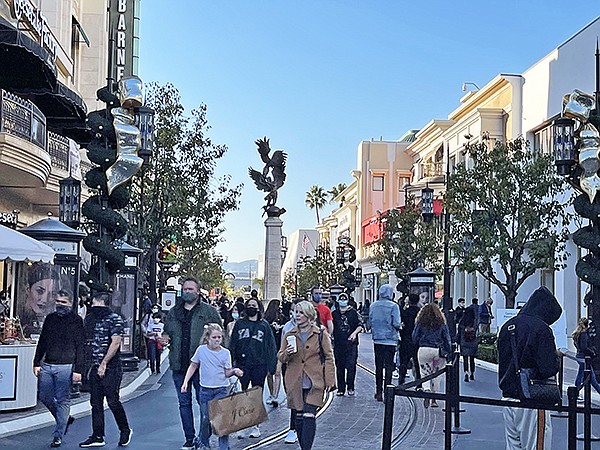Regulations on crowd size at local malls, such as The Grove—shown above—and The Bloc—shown below, was helped by curbside and in-store pickup and consumers wanting to absorb a little of the holiday spirit. Still, e-commerce ruled the season.
RETAIL
With Holiday Sales Up, Now Retailers Must Strategize for 2021
Initial reports from the 2020 holiday season were recently released, and retail sales experienced growth during a year fraught with challenges. Retail sales charted from Oct. 11 to Dec. 24 grew 3 percent, according to Mastercard SpendingPulse, which researches consumer spending on the Mastercard payments network.
Mastercard SpendingPulse found that predictions of a big e-commerce surge came true as COVID-19 pandemic restrictions reduced crowds from shopping at malls and on retail streets. The report showed that e-commerce sales increased 49 percent and that e-commerce was 19.7 percent of overall sales during the holiday season.
Apparel retailers experienced an overall decline of 19.1 percent in business compared to the 2019 holiday season; however, apparel e-commerce sales grew by 15.7 percent. Department stores experienced an overall sales decline of 10.2 percent and online sales growth of 3.3 percent.
While predictions of an e-commerce surge came to fruition during 2020, the changes to traditional holiday retail were jarring, said Steve Sadove, senior adviser for Mastercard and former chief executive officer and chairman of Saks Incorporated.
“American consumers turned the holiday season on its head, redefining ‘home for the holidays’ in a uniquely 2020 way. They shopped from home for the home, leading to record e-commerce growth,” Sadove said.
Now that the books are closing on holiday business, retail analysts have advised businesses and consumers to prepare for more changes. Analysts are trying to figure out what shape retail will take in a post-pandemic world.
If one thing is for certain, there will be a myriad of channels for consumers to shop. One channel that experienced tremendous growth during 2020 is BOPIS/buy online, pickup in store, which enjoyed 82 percent growth in 2020, said Inna Kuznetsova, chief executive officer of market researcher 1010data.
Afterpay, an e-payments company that allows consumers to buy goods and pay for them on a layaway plan, said in a Jan. 4 statement that holiday business was good. Its customers’ average basket size, or number of items sold in a single purchase, increased 30 percent compared to the 2019 holiday season.
Retail on social media also made if not a splash a ripple during the past year. Expect this channel to grow, said Tyler Higgins, retail practice lead and managing director at the global consulting firm AArete.
“Sales outlets will continue to expand in 2021 from historic bricks-and-mortar stores and store websites into channels such as social media. We expect a boom in sales through TikTok, Instagram and similar platforms that have already become strong sales channels,” Higgins said.
Also expect more omni-channel retail, said Katie Thomas, who leads the Kearney Consumer Institute.
“2021 is going to be a year in flux. Even with the vaccine it’ll be a slow migration back to some sense of stability. I’m not convinced when I hear that people will never go back to the stores now that they’re used to the delivery option. It’s not delivery or the store, it’s delivery and the store,” she said. “There is a challenge retailers will have to be thinking about with online shopping, which is harder to get in the basket—shoppers following off a list versus making impulse purchases in-store. Obviously, there’s all sorts of data and algorithms with complimentary offerings and so on, but I think from a consumer perspective we still haven’t quite figured out how to position online retail.”
When pandemic restrictions are eased, retailers will be pressed to serve consumers by running bricks-and-mortar spaces and managing digital footprints, said Syama Meagher, CEO of the Scaling Retail consultancy. It will be more expensive to run a business in a post-pandemic world because businesses will have to support a number of different channels to serve customers.
Meagher recommended that smaller retailers focus on and excel in one digital channel as they reactivate physical retail.
“A lot of people started with Pinterest and Facebook and tried to be everywhere. I’d double down on a very specific channel and also start to incorporate a safe ‘In Real Life” pop-up activation,” she said.
Retailers will also have to rethink what products they merchandise.
“We’re entering into a new wave of consumer behavior,” Meagher said. “One of the major questions retailers should ask: ‘Is our existing product assortment ready to capture the pocketbooks of consumers today?’ Brands must ask if they are catering to a 2021 lifestyle. Everything is up in the air. People are working from home. Lots of parents found themselves serving as their kids’ teachers. A lot of people are cash-strapped.”























